
views
Cleaning Dirty Bricks with Household Items

Vacuum any dust and dirt. Use a vacuum cleaner with a brush attachment to suck away dirt and dust. Brush away dirt with the attachment to loosen any stubborn areas. If you can't remove all of the dirt, don't worry. You can scrub away more with soap and water later.
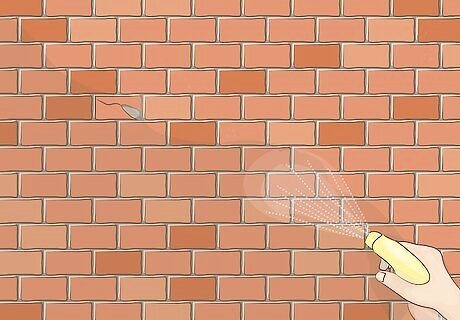
Get the brick wet before using any cleaners. Dry bricks will absorb the cleaning solvent and fade or discolor over time. Fill a spray bottle with water and saturate the brick's entire surface before using any cleaners. Washing a dry brick can also cause it to grow unsightly white or greenish scum. If you're washing a brick outside, you can also use a garden hose to get it wet.

Scrub the brick with a mixture of dish soap and table salt. Combine 1 c (0.24 L) each of dish soap and table salt to make a spreadable paste, then spread the paste in an even layer over the surface. Working from top to bottom, scrub the paste into the brick with a bristle bush. 1 c (0.24 L) of this mixture should be enough to clean 1 small or medium-sized brick. Let the paste sit for 5-10 minutes before scrubbing it with the bristle brush. Remove the paste from the brick with a wet washcloth.
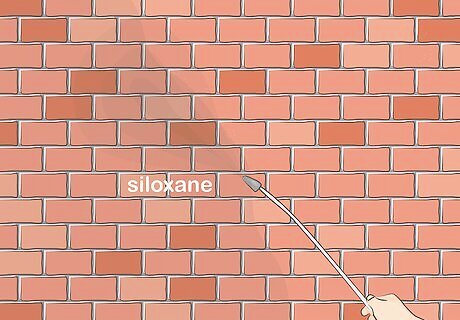
Use a sealant to keep the brick in good condition. Let your brick sun-dry or dry it with a towel. Spray a siloxane- or silane-based sealant around the brick's entire surface, keeping the sealant nozzle several inches away to keep the coating even. Use sealants in well-ventilated outdoor areas, reading the instructions carefully to apply them safely and effectively. Look for brick sealants online or at a home repair store. Spray a water repellent over the brick to prevent water-related damage and protect the bricks if you live in a wet or rainy climate.
Lifting Stubborn Stains with Acid Cleaners
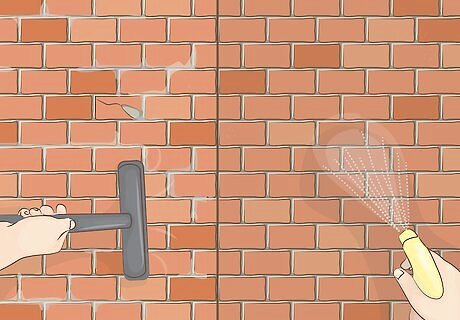
Vacuum and wet the brick before applying the cleaner. Like using household cleaners, your brick will absorb the less of the cleaner if it has been vacuumed and dampened with water first. Don't worry about removing deep-set stains, as the acid cleaner will remove them later on. You can also dry brush the brick to remove dirt as an alternative to vacuuming.

Cover the area surrounding the brick with a tarp. Acid cleaners are corrosive and can damage nearby objects. Lay a drop cloth or plastic tarp over areas surrounding the stained brick.

Wear safety goggles and rubber gloves while handling acid cleaners. Because acid cleaners are hazardous, they can cause serious injuries if they come in contact with your eyes or skin. Put on thick rubber gloves and safety goggles before handling the acid to protect yourself from burns. Read the acid cleaner's safety instructions carefully before using it to prevent injuries.
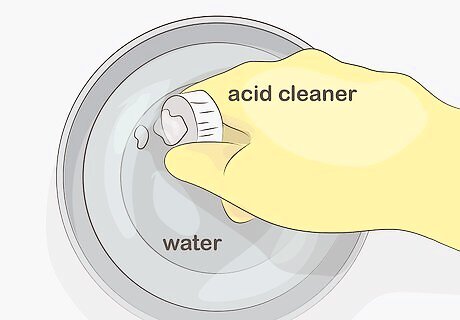
Mix the acid cleaner with water. Fill a bucket halfway with water, then pour in a small amount of acid cleaner. Check the acid cleaner's instructions for the exact ratio, as the cleaner's strength and concentration level can affect how much dilution it needs. Make sure you pour the acidic cleaner into the water (instead of the other way around) to prevent chemical burns caused by splashes. You can get acid cleaners for brick through a local brick supplier.
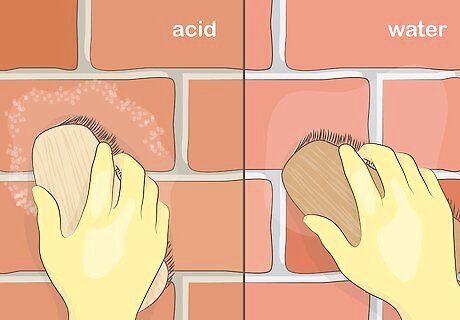
Apply the acid cleaner to the brick. Dip a bristle brush in the acid cleaner and gently apply it to the stained area in strokes. Let the brick absorb the cleaner for 3-5 minutes, then use another bristle brush dampened with water to scrub away the stain.
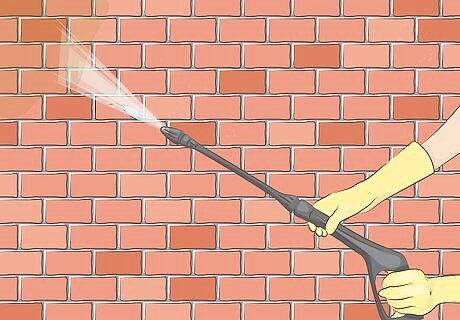
Wash away the acid and let the brick dry. After scrubbing away the stain, wash the acid off with a hose and leave the brick to air dry. Inspect the brick for any residual stains. If any stains remain afterward, try increasing the acid cleaner's concentration and applying it again if the packaging says it is safe to do so. Like when removing dirt or minor stains, you can also spray a sealant or water repellent on afterward to protect the brick from future damage.
Repointing Brick Mortar Joints
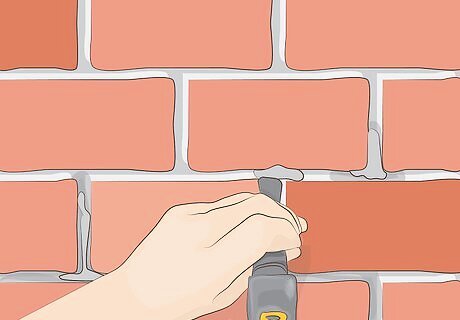
Use a hammer and chisel to chip away the old mortar. Position your chisel underneath the mortar at an angle and hit it with a hammer to cut away the damaged areas. Work your way along the tops and sides of the brick to remove the mortar from the vertical and sideways joints. Wear a respirator, pair of work gloves, and safety goggles while chipping away mortar to protect your eyes, hands, and lungs. After cutting away the mortar, use a wire brush or hose to remove the dust.

Soak the wall with water and let it sit overnight. Use your hose to get the bricks wet, which will ensure that they don't suck the hydration out of the new mortar. Leave the bricks alone overnight to soak up water and repoint them the next day. Before repointing the mortar, spritz it again with water to make sure that the brick absorbs enough water.

Mix a brick mortar batch. Mix a ratio of sand and cement as instructed by the mortar packaging with a shovel, forming a crater in the center. Use the shovel to put dry mix into the center crater, and let it sit for about 3-5 minutes before applying it to the wall. Buy brick mortar mix from a hardware or home improvement store. You can also purchase premixed mortar from most home improvement stores as an alternative. Bring a piece of the old mortar to the store so you can get new mortar in a matching color. Because brick mortar hardens quickly, make it wet in small batches.
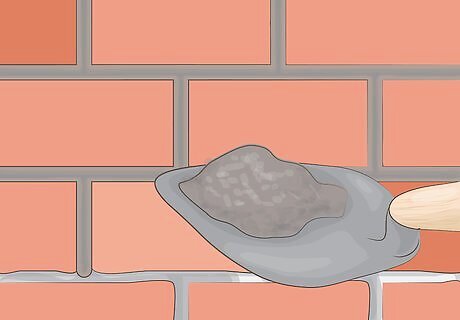
Insert the new mortar into the joints. Place a small amount of mortar on your trowel and work it into the horizontal and vertical gaps surrounding your brick. After applying the mortar, let it harden for 20-30 minutes. Then, use a jointer tool to shape off the mortar. To make your brick more weather-resistant, give the mortar inside the joints a slight concave shape. After the mortar has hardened, scrape away any that accidentally got on the brick's surface with a wire brush.
Replacing a Loose Brick

Chip away the old mortar with a chisel. Holding the chisel at a slight angle, work it underneath the mortar and hit it with a hammer. Chip away at the mortar until the brick is loose and you're able to wiggle it free. Put on a pair of safety goggles, respirator, and work gloves to protect your eyes, lungs, and hands. If possible, use a cold chisel (also called a cape chisel) to complete this task. Cold chisels have a wedge-shaped point, and you can purchase them online or at some home improvement stores.
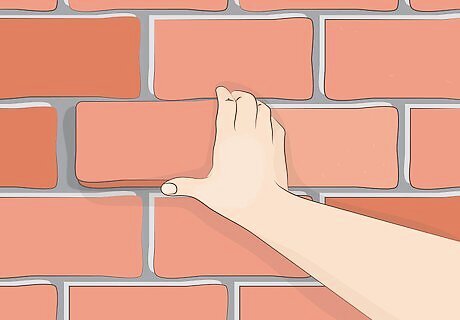
Pull out the loose brick. Grab the corners of the loose brick with your hands and slide it out of the cavity. When you've removed the old mortar and taken out the brick, use a broom or vacuum to remove any dust from it and the cavity. Remove all of the mortar after pulling out the block until the cavity is completely empty. Dampen the empty brick cavity with water to help the new mortar adhere.

Scrub the brick with a wet bristle brush. Using a wet bristle brush, remove any dust and debris from the brick's surface. This will help the mortar adhere to the brick and prevent it from cracking in the future. If the brick is significantly dirty, surface clean it before applying the new mortar.

Mix a batch of brick mortar. Mix a ratio of sand and cement (as determined on the mortar mix packaging) with a shovel, forming a crater in the middle of the mix. Use the shovel to put dry mix from the side into the center crater, and let it sit for about 3-5 minutes before using. You can buy brick mortar from most home improvement stores or online. If you don't want to mix the mortar yourself, you can also buy it pre-mixed.
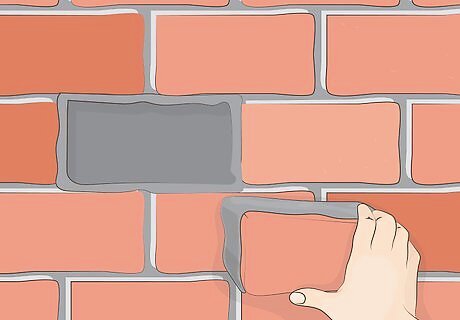
Apply the mortar to the dampened brick and cavity. Add a ⁄2 in (1.3 cm) layer to the interior surface of the cavity and the top of the brick with a trowel. Make the layer as even as possible to help the brick adhere well to the cavity. Give the mortar inside the joints a slight concave shape to make it more weather-resistant.
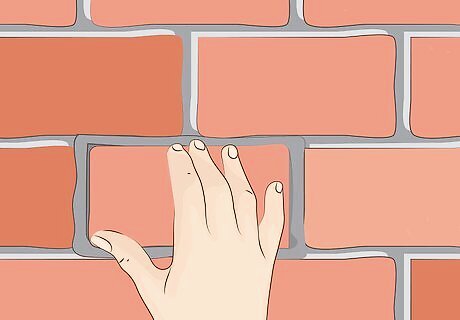
Re-set the brick into the cavity. Slide the brick into the cavity, pushing on the side with your hands to set it all the way in. Use your trowel to add more mortar along the brick's horizontal and vertical joints, scraping away extra mortar and evening out the joints as you work.

Let the mortar dry for 1-2 days. When you've put the brick in place and added mortar to the joints, leave the mortar to dry for 24-48 hours. After it's completely dry, use a wire brush to remove dried mortar from the brick's surface as needed




















Comments
0 comment